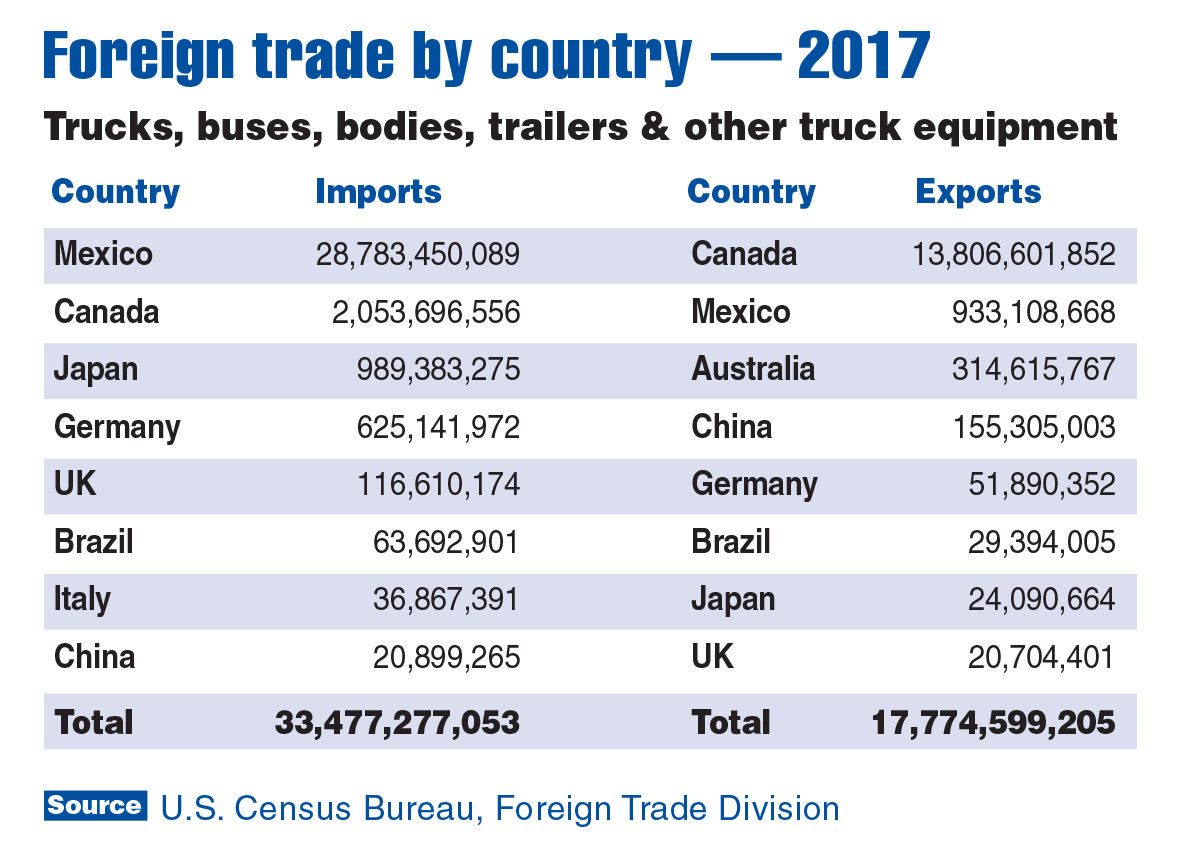By Steve Latin-Kasper
NTEA Director of Market Data & Research
This article was published in the November 2018 edition of NTEA News.
Key highlights
- Last year, total exports of commercial trucks/chassis, buses, bodies, trailers and other truck equipment rose to $17.8 billion from $16.2 billion in 2016.
- Imports reached a new record of $33.5 billion in 2017.
- The majority of global trade for U.S.-based work truck industry companies involves Canada and Mexico

In 2017, total exports of commercial trucks/chassis, buses, bodies, trailers and other truck equipment rose to $17.8 billion from $16.2 billion in 2016. (The record of $19.4 billion was established in 2013.) The total value of commercial truck industry exports fell below $16 billion in 2015, but has been increasing since. Imports reached $33.5 billion in 2017, which is a new record exceeding the $33.1 billion registered in 2015.

The chart above shows the majority of global trade for U.S.-based work truck industry companies involves Canada and Mexico, the nation’s partners in United States-Mexico-Canada Agreement (USMCA) — formerly known as NAFTA. Mexico is by far the largest exporter of commercial truck industry products to the U.S.
The majority of Mexico’s work truck industry exports to the U.S. are trucks and tractors. Almost $12 billion of the $28 billion total are Class 2 and 3 vehicles (pickups, commercial vans) with gasoline-fueled engines. About $6 billion are road tractors, and $4 billion are gasoline-fueled Class 1 trucks. Another $2.5 billion are diesel engine Class 1–3 trucks.
Work truck industry products exported from the U.S. to Canada are almost identical to those being imported from Mexico. About $8.3 billion of the Canadian exports are gasoline-fueled Class 2–3 trucks, and $1.3 billion of the total are road tractors. Diesel-fueled Class 1–3 and Class 4–5 trucks/chassis account for $1 billion each.
Since we’re nearing a cyclical peak, it’s helpful to compare current Mexico and Canada trade figures to the previous cyclical peak in 2006. During that year, the total imported from Mexico was $9.6 billion — almost one-third of the 2017 total. Exports to Canada were $12.2 billion, which is about $1.6 billion less than the 2017 total.
The increase in imports from Mexico was primarily due to multiple OEMs expanding North American production capacity by building new plants in Mexico. Most of the vehicles built in those plants were expected to be sold in the U.S. The primary impact of expanding North American production in Mexico instead of in the U.S. was some percentage of U.S. sales being shipped from Mexico, instead.
It isn’t possible to determine the effect on U.S. exports to Canada, which clearly increased during that period. From an OEM perspective, it doesn’t matter as much, since they tend to view North America as one market. With NAFTA in place, it made sense, and isn’t expected to change with USMCA.
The data in the chart above is sourced from U.S. Census Bureau, Foreign Trade Division. U.S. Imports of Merchandise is the import publication, and U.S. Exports of Merchandise is the export publication. NTEA compiles annual commercial truck and equipment industry totals for all countries and products.
To clarify, industry totals shown in the chart above are not comprehensive. For example, we don’t know how many service bodies or liftgates are imported or exported. However, NTEA’s Annual Manufacturers’ Shipments Survey makes it clear exports of most equipment and body types do not account for a significant percentage of sales, so the totals in the chart are close to accurate. Learn more about this resource at ntea.com/amss.
Visit ntea.com/marketdata to find key publications, reports and regular market updates (member login required to view some content).
The Work Truck Show® 2019 offers additional market date resources and insights as part of its educational programming, including Work Truck Industry Overview and Outlook and Translating Commercial Vehicle Data into Practical Business Insights. Learn more at worktruckshow.com/educate.